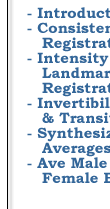
 |
|||||
 |
|||||
Next: Limitations of Diffeomorphic Transformations Up: Discussion Previous: Spatial Multiresolution
Comparison to other methods
Other investigators have proposed methods for enforcing pairwise consistent
transformations. For example, Woods et al. [27] computes all pairwise registrations of
a population of image volumes using a linear transformation model, i.e.,
a
![]() matrix transformation. They then average the transformation
from
matrix transformation. They then average the transformation
from ![]() to
to ![]() with all the transformations from
with all the transformations from ![]() to
to ![]() to
to ![]() . The original transformation from
. The original transformation from ![]() to
to ![]() is replaced with average transformation. The procedure is repeated
for all the image pairs until convergence. This technique is limited by
the fact that it can not be applied to two data sets. Also, there is no
guarantee that the generated set of consistent transformations are valid.
For example, a poorly registered pair of images can adversely effect all
of the pairwise transformations.
is replaced with average transformation. The procedure is repeated
for all the image pairs until convergence. This technique is limited by
the fact that it can not be applied to two data sets. Also, there is no
guarantee that the generated set of consistent transformations are valid.
For example, a poorly registered pair of images can adversely effect all
of the pairwise transformations.
The method proposed in this paper is most similar to the heuristic approach
described by Thirion [6]. Thirion's idea was to iteratively estimate
the forward ![]() , reverse
, reverse ![]() , and residual
, and residual
![]() transformations in order to register the images
transformations in order to register the images ![]() and
and ![]() . At each iteration, half of the residual
. At each iteration, half of the residual ![]() is added to
is added to ![]() and half of the residual
and half of the residual ![]() is mapped through
is mapped through ![]() and added to
and added to ![]() . After performing this operation,
. After performing this operation, ![]() is close to the identity transformation. The advantage of
Thirion's method is that it enforces the inverse consistency constraint
without having to explicitly compute the inverse transformations as in
Eq. 3. The residual method is
an approximation to the inverse consistency method in that the residual
method approximates the correspondences between the forward and reverse
transformations while the inverse consistency method computes those correspondences.
Thus, the residual approach only works under a small deformation assumption
since the residual is computed between points that do not correspond to
one another. This drawback limits the residual approach to small deformations
and it therefore can not be extended to nonlinear transformation models.
On the other hand, the approach presented in this paper can be extended
to the nonlinear case by modifying the procedure used to calculate the
inverse transformation to include nonlinear transformations.
is close to the identity transformation. The advantage of
Thirion's method is that it enforces the inverse consistency constraint
without having to explicitly compute the inverse transformations as in
Eq. 3. The residual method is
an approximation to the inverse consistency method in that the residual
method approximates the correspondences between the forward and reverse
transformations while the inverse consistency method computes those correspondences.
Thus, the residual approach only works under a small deformation assumption
since the residual is computed between points that do not correspond to
one another. This drawback limits the residual approach to small deformations
and it therefore can not be extended to nonlinear transformation models.
On the other hand, the approach presented in this paper can be extended
to the nonlinear case by modifying the procedure used to calculate the
inverse transformation to include nonlinear transformations.
Next: Limitations of Diffeomorphic Transformations Up: Discussion Previous: Spatial Multiresolution Xiujuan Geng 2002-07-04
Copyright © 2002 • The University of Iowa. All rights reserved.
Iowa City, Iowa 52242
Questions or Comments: gary-christensen@uiowa.edu